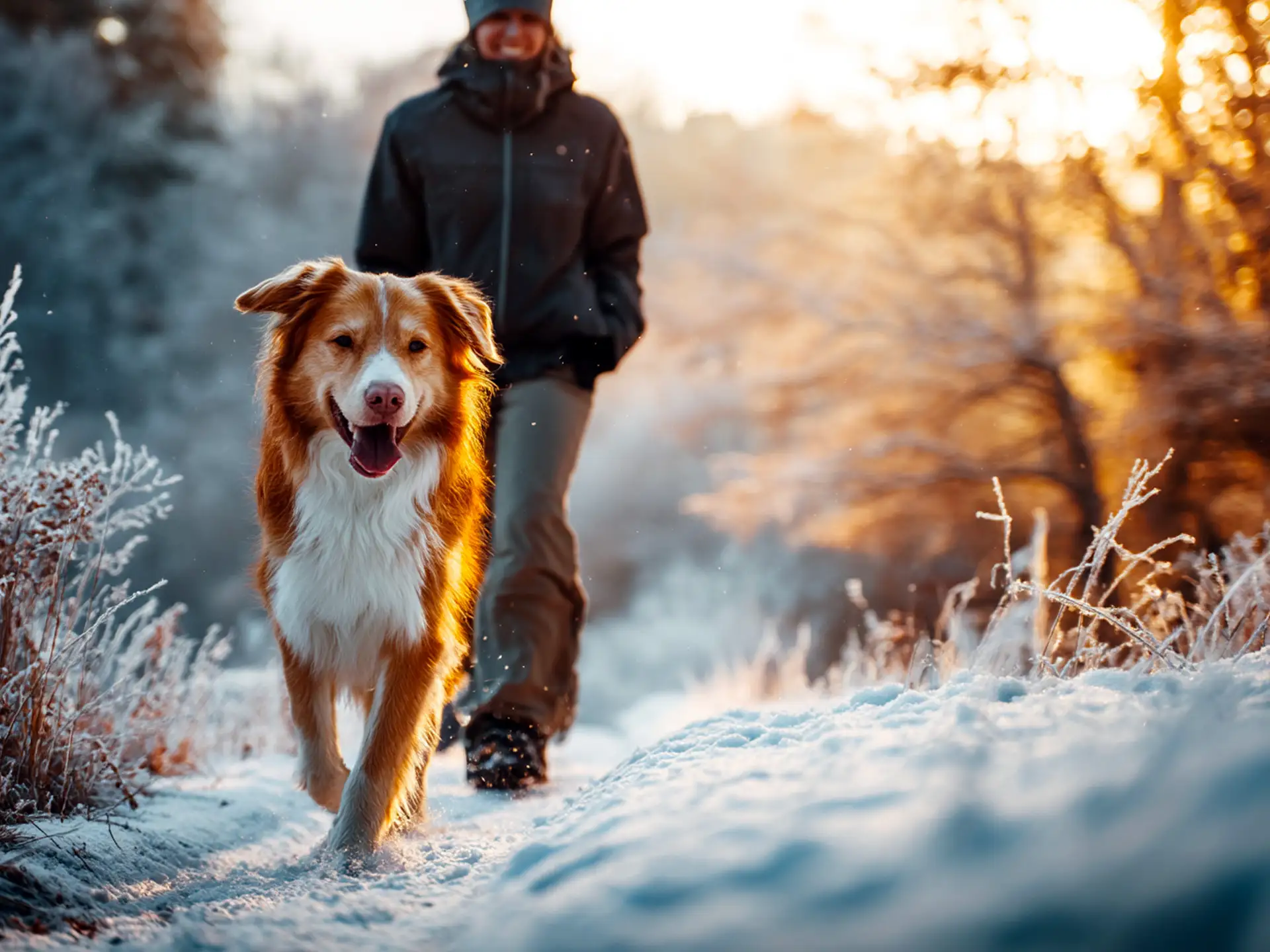Every dog owner knows that look. The eager eyes, the wagging tail, the silent plea that says “Walk?” When winter hits, the question isn’t whether your dog wants to go outside. It’s whether they should.
- Understanding How Dogs Handle Cold
- How Cold Is Too Cold to Walk a Dog (Temperature Chart and Guidelines)
- Signs Your Dog Is Too Cold During a Walk
- How Cold Is Too Cold for Dog Paws
- Can Dogs Walk in the Snow
- Tips for Walking Dogs Safely in Winter
- How Long Should You Walk Dogs in Cold Weather
- Winter Walking Schedule for Working Owners
- Final Takeaway
- Frequently Asked Questions
Cold weather walks are part of life for most dogs, but what counts as too cold depends on much more than the number on your weather app. Breed, size, coat type, wind chill, humidity, and even your dog’s age all shape how safely they can handle a chilly stroll.
This guide covers everything about walking dogs in cold weather: how temperature affects different breeds, how to protect their paws, and how long winter walks should last. By the end, you’ll know exactly when it’s safe to head out and when it’s better to keep your dog warm indoors.
So, how cold is too cold to walk a dog?
Most healthy adult dogs can walk safely until temperatures drop below 32 °F (0 °C). Once the air reaches 20 °F (minus 6 °C) or lower, walks should last only 10–20 minutes, and below 10 °F (minus 12 °C) it’s best to stick to quick bathroom breaks.
Understanding How Dogs Handle Cold
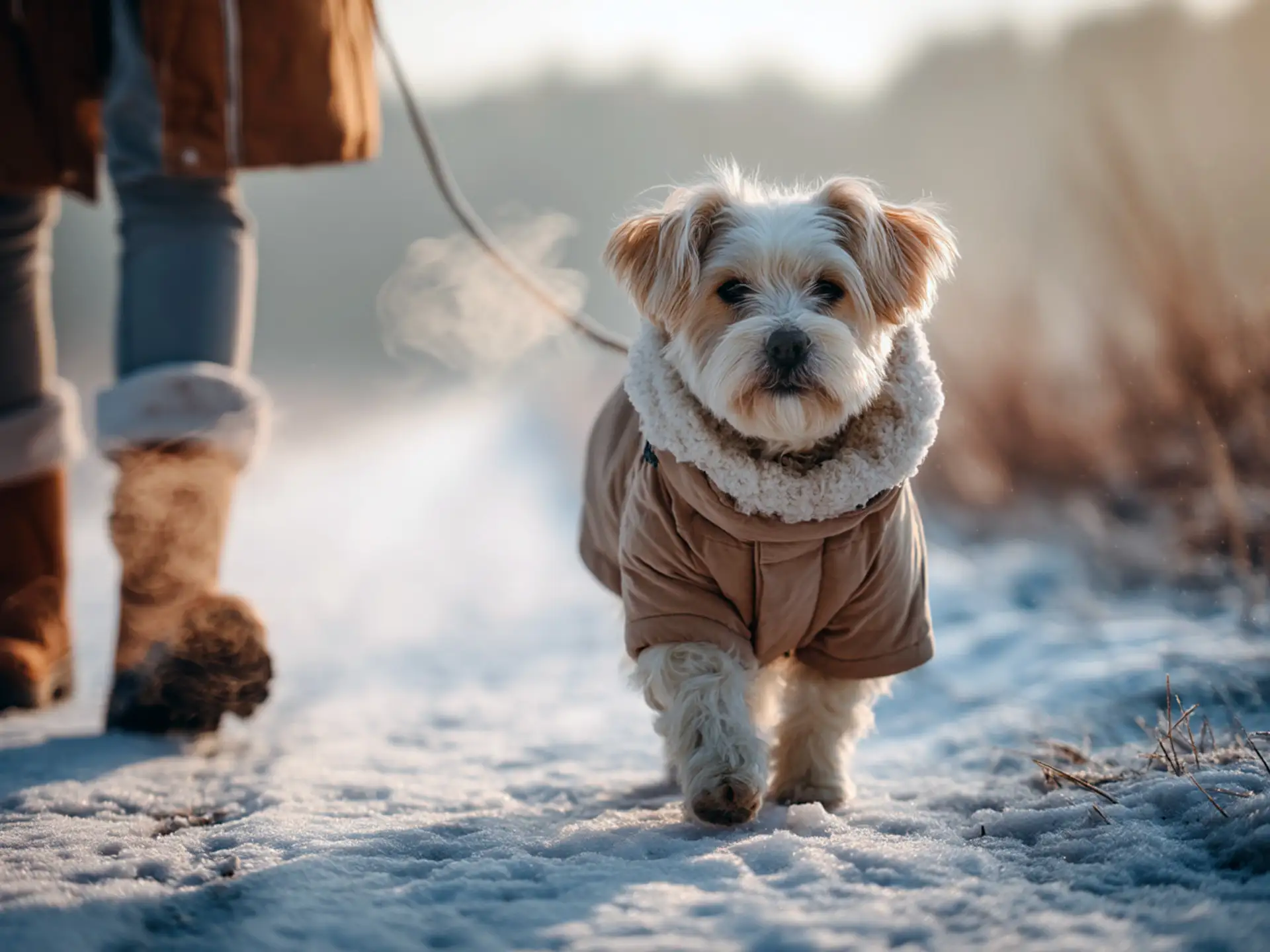
Dogs have wildly different relationships with winter. A Husky dashes into a snowstorm as if born for it, while a short-haired Vizsla might shiver before you’ve even zipped your coat. The difference lies in anatomy, conditioning, and a touch of instinct that tells each dog when it’s time to go home.
The science behind a dog’s cold tolerance
A dog’s coat is its natural insulation. Breeds with double coats, like Malamutes, Shibas, and Bernese Mountain Dogs, trap warm air between two layers of fur that protect against icy winds. Short-haired or single-coated dogs lack this barrier, which means they lose heat faster, especially in wet or windy conditions.
Body fat, muscle tone, and size also influence heat retention. Smaller dogs cool down quickly because they have more surface area relative to their body mass, while lean athletic dogs, such as Greyhounds, can’t store warmth for long.
Age, health, and conditioning
Just like humans, a dog’s ability to handle cold changes over time. Puppies and senior dogs struggle to regulate temperature efficiently, and those with arthritis, thyroid issues, or thin body condition are more vulnerable. A brisk winter walk that’s invigorating for a healthy adult Lab can feel exhausting to an older Beagle.
Conditioning matters too. Dogs accustomed to regular outdoor play in autumn adapt better to dropping temperatures than those who spend most of their days indoors.
Environmental factors that change everything
Temperature is only part of the equation. Wind, moisture, and humidity can drastically alter how cold it feels. A dry, calm 25°F day may be manageable for many dogs, while a damp, windy 35°F can cause discomfort in minutes. Wet fur stops insulating effectively, and standing water or ice pulls heat away through the paws.
When you evaluate the weather, think about how it feels on your skin. If the air bites your fingers after a few minutes, it’s time to shorten the walk or add protective gear.
Key takeaway
Cold tolerance isn’t about the number on a thermometer, it’s about your dog’s unique build, health, and environment. The goal isn’t to avoid winter entirely but to recognize when conditions stop being fun and start becoming unsafe.
How Cold Is Too Cold to Walk a Dog (Temperature Chart and Guidelines)

Every winter, dog owners search for the magic number, the temperature that marks the line between “fine for a walk” and “too cold to risk it.” The truth is, there isn’t one universal cutoff. What matters most is how temperature interacts with wind, moisture, and your dog’s own tolerance. Still, having a general guide helps you make quick, safe decisions before every outing.
The safe-temperature guide
The following chart summarizes how most healthy dogs respond to different temperature ranges. Think of it as a flexible framework rather than a strict rulebook.
| Temperature (°F) | Comfort level | What it means for your walk |
|---|---|---|
| Above 45°F (7°C +) | Comfortable for all breeds | Normal walks, no special precautions needed. |
| 32 – 45°F (0 – 7°C) | Mildly cool | Great for medium or large breeds; smaller or short-haired dogs may need a coat. |
| 20 – 32°F (–6 – 0°C) | Cold | Shorten walks to 20 minutes or less; consider paw balm or boots. |
| 10 – 20°F (–12 – –6°C) | Very cold | Limit to quick potty breaks; small or thin dogs should stay mostly indoors. |
| Below 10°F (–12°C or lower) | Dangerous | Risk of frostbite and hypothermia. Skip the walk and focus on indoor enrichment. |
The hidden factor: wind chill
Wind chill changes everything. A calm 25°F can feel mild, but add a steady wind and it becomes biting. Moving air strips away the warm layer surrounding your dog’s body, causing faster heat loss, especially for small or short-haired breeds. Always check the “feels like” temperature on your weather app, not just the number at the top.
Moisture matters more than you think
Snowy fur looks cute in photos but dangerous in reality. Once fur gets wet, it stops insulating, and paws quickly chill on icy ground. Even a few minutes of standing on slush can make a noticeable difference. If your dog’s paws or belly are damp after the walk, dry them thoroughly and let your dog warm up indoors before heading out again.
Watch the individual cues
Every dog tells you when it’s too cold, you just have to notice the signs. Paw lifting, shivering, or tucking the tail close to the belly are early warnings that the walk should end soon. If your dog slows down or tries to turn back toward home, listen to them.
Key takeaway
Temperature guidelines are useful, but your dog’s comfort always comes first. When in doubt, shorten the route, add protective gear, and make up for lost exercise with indoor play or scent games.
Signs Your Dog Is Too Cold During a Walk
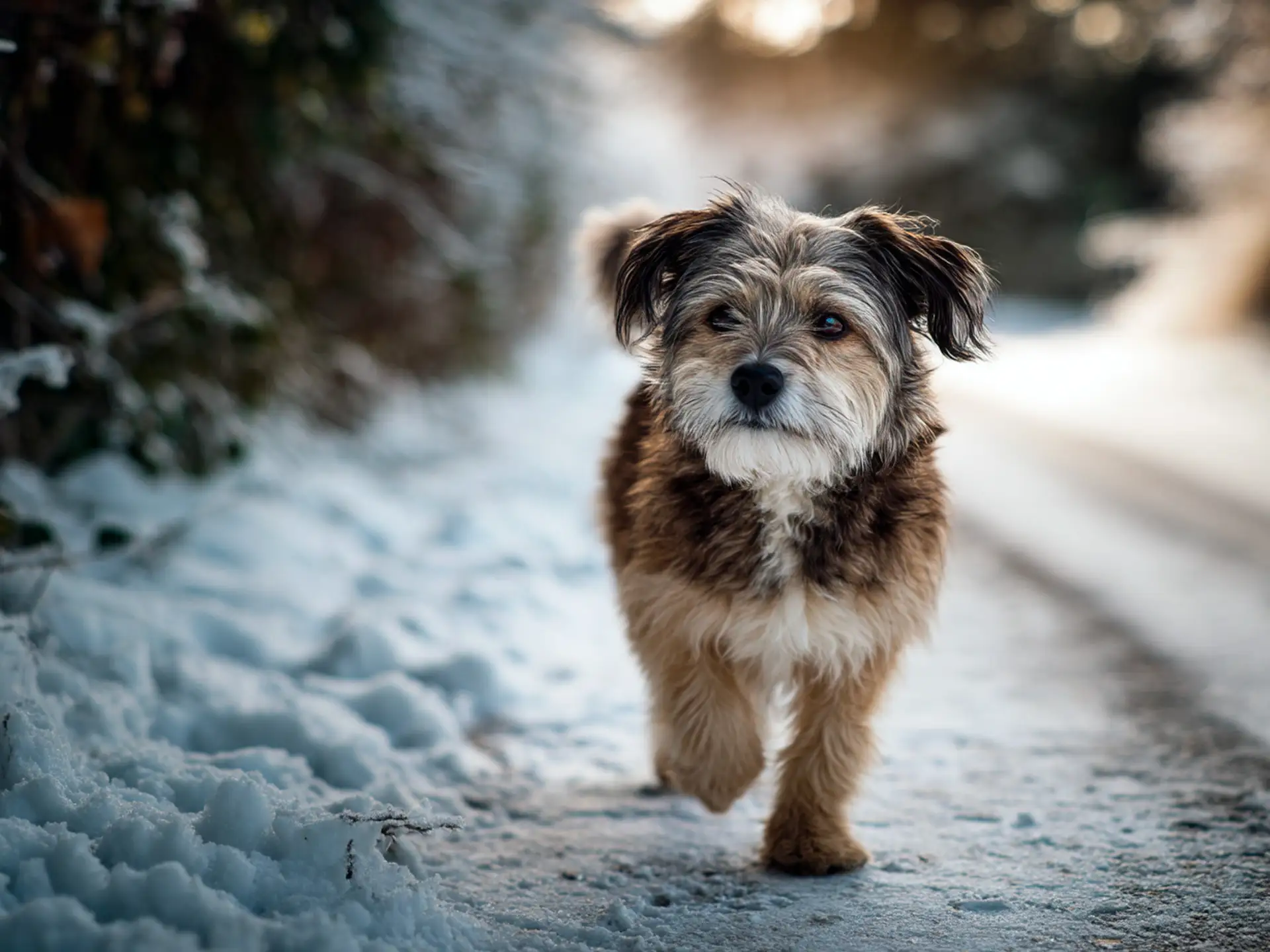
Dogs are remarkably expressive, and when the cold starts to bother them, they rarely hide it. The trick is learning to recognize the small changes that signal it’s time to head home. Knowing these signs can help you prevent frostbite, hypothermia, and unnecessary stress during winter walks.
Behavioral cues that appear first
The earliest warnings are often subtle. Your dog may begin to slow their pace or lift their paws more often, trying to avoid contact with the cold ground. Some will lick or chew at their paws mid-walk, which usually means their pads are getting numb or irritated by salt or ice. Shivering is the clearest and most universal sign of discomfort, especially if your dog normally enjoys the cold.
If your dog starts to tuck their tail under, hunch their body, or repeatedly look toward home, they’re telling you that the fun is over. Small or short-coated breeds may even start to tremble before showing these other cues.
Physical signs of overexposure
Once cold exposure deepens, you may notice physical changes. Paw pads can turn pale, bluish, or even gray if circulation drops. Ears and tail tips are also vulnerable to frostbite in extreme weather. In severe cases, your dog may become disoriented, lethargic, or unresponsive — all signs of early hypothermia that require immediate warmth and, if symptoms persist, a call to your veterinarian.
| Symptom | What it may indicate | What to do |
|---|---|---|
| Paw lifting or licking | Pads are cold or irritated | Check for ice or salt, rinse and dry paws |
| Shivering or trembling | Early discomfort | Shorten the walk, add a coat or boots |
| Pale or hard paw pads | Circulation loss or frostbite | End the walk and warm gently indoors |
| Sluggish movement or disorientation | Early hypothermia | Wrap in a blanket and contact your vet if it continues |
Helping your dog warm up safely
If your dog seems cold after a walk, move them into a warm, dry room immediately. Use a soft towel to dry their paws and belly, then offer water to help regulate body temperature. Avoid direct heat sources such as hair dryers or space heaters. Instead, let warmth return gradually. A snuggle under a blanket and a few minutes of calm indoor play often do the trick.
Key takeaway
Winter walks are healthy and stimulating, but the cold can turn dangerous quickly if warning signs go unnoticed. The more familiar you are with your dog’s normal body language, the faster you’ll recognize when something feels off.
How Cold Is Too Cold for Dog Paws
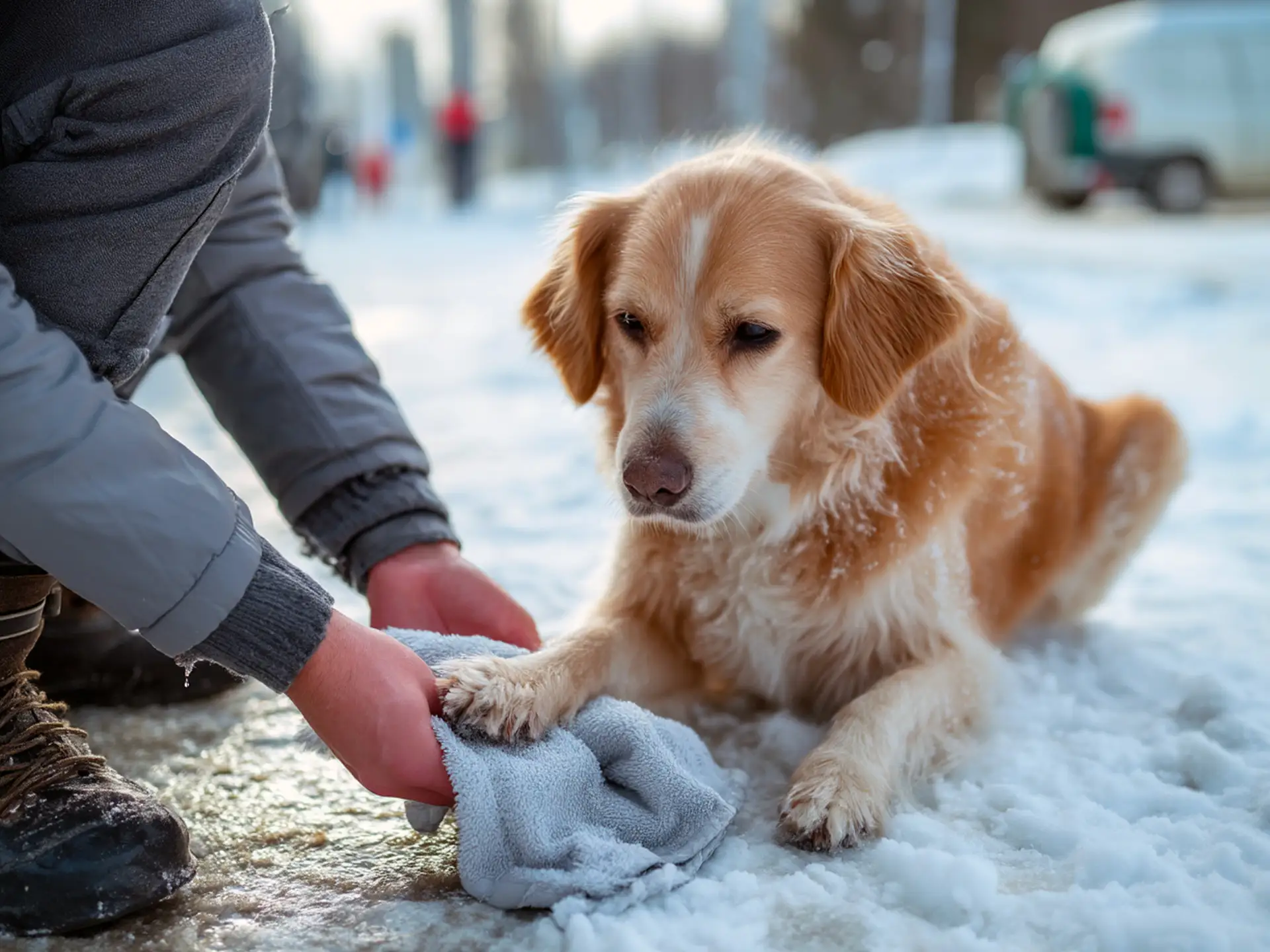
Your dog’s paws are tougher than they look, but they are still vulnerable to winter’s extremes. Those pads are designed to grip, cushion, and regulate heat, yet when they meet freezing ground or road salt, they can quickly become sensitive, cracked, or even frostbitten. Understanding what happens to paws in cold weather and how to protect them is essential for safe winter walks.
Why paws struggle in winter
Unlike a dog’s coat, the paw pads have no layer of fur to trap heat. When paws touch ice, snow, or cold pavement, warmth leaves the body almost immediately. Wet surfaces make this effect even stronger because water conducts heat away faster than air. In temperatures below freezing, it takes only a few minutes of contact for skin tissue to stiffen and blood flow to slow.
Salt and ice melt compounds add another layer of risk. They can cause irritation, chemical burns, and in some cases mild poisoning when a dog licks their paws after the walk. Even hardy breeds can show discomfort after a few blocks on salted streets.
The danger signs to watch for
Cold-related paw injuries often start quietly. A dog may begin lifting one paw or licking repeatedly. Pads might look dry, rough, or whitish rather than healthy pink. In severe cases the edges of the pads turn gray or bluish, which signals possible frostbite. If your dog limps, refuses to walk, or keeps stopping to lick, it is time to go home and warm up gradually.
How to protect paws in cold conditions
Before each walk, apply a thin layer of paw balm or wax to act as a barrier against moisture and salt. For city walks or deep snow, use well-fitted boots that keep paws dry while maintaining traction. Introduce them indoors first so your dog feels comfortable wearing them outside.
After the walk, rinse paws with lukewarm water to remove salt and debris, then dry them completely with a soft towel. Check between the toes for trapped ice or redness. A pet-safe moisturizer can help repair dry or cracked pads. Consistent care keeps paws resilient throughout the season.
When it is too cold for bare paws
Most dogs can tolerate dry snow and brief contact with cold ground down to around 20°F (minus 6°C). Once temperatures fall near 10°F (minus 12°C), unprotected paws face real danger from frostbite and salt exposure. Small, thin-coated, or elderly dogs should wear boots whenever the air dips below freezing, especially on salted sidewalks or icy trails.
Key takeaway
Healthy paws mean safer winter walks. Regular protection and quick post-walk care prevent most cold-weather injuries. When in doubt, test the ground with your bare hand. If it feels painfully cold after a few seconds, your dog needs protection or a shorter route.
Can Dogs Walk in the Snow
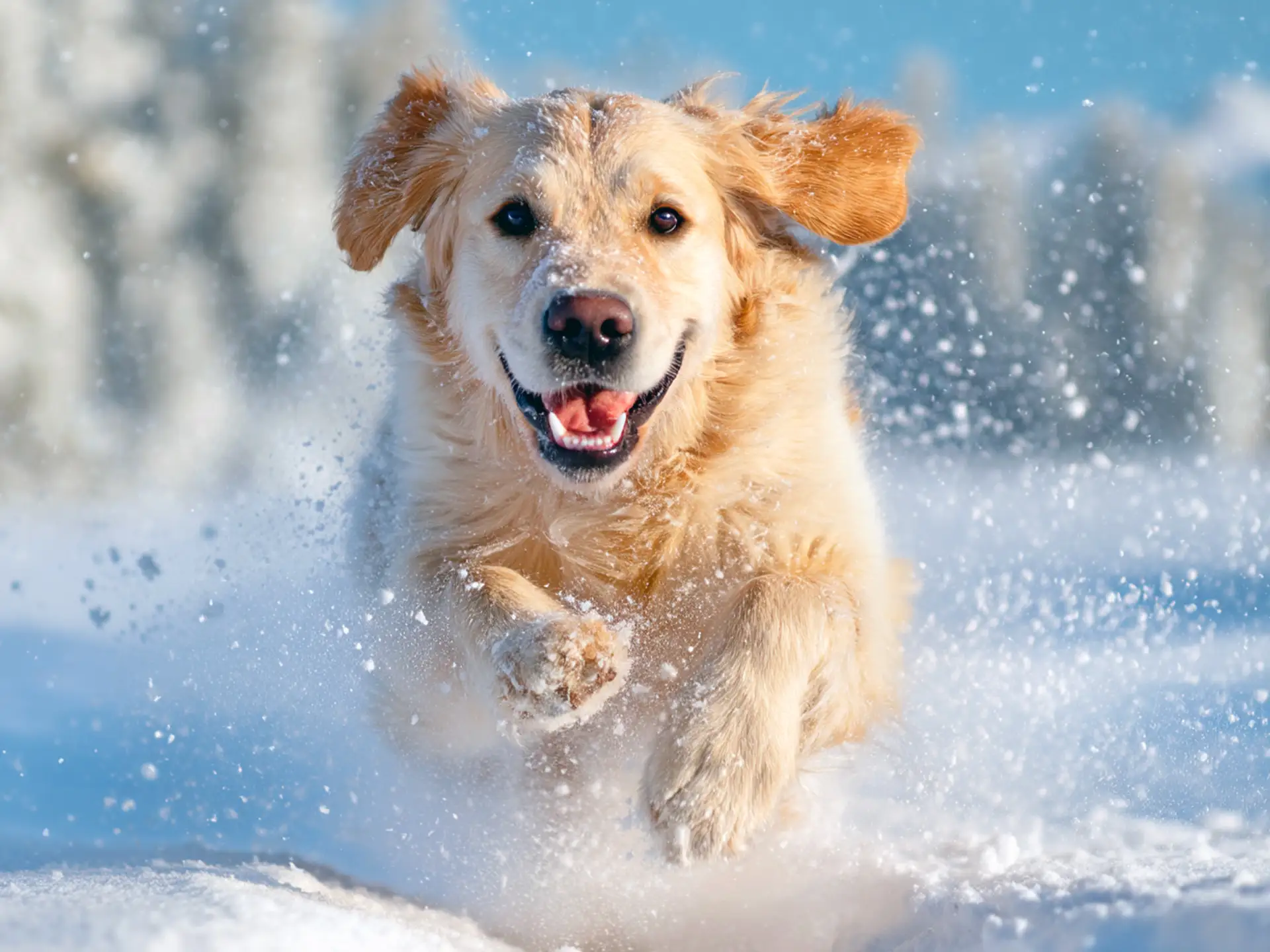
For many dogs, snow is pure magic. The air smells sharper, the world turns into a playground, and every step leaves a satisfying crunch. But while snow can make walks more exciting, it also changes the environment in ways that challenge your dog’s body. Understanding how to judge conditions and prepare properly makes all the difference between a joyful outing and a risky one.
How dogs experience snow
Most dogs love snow because it amplifies scent and texture. Their paws act as sensory tools, helping them read the world through touch and smell. Fresh snow holds scents better than dry soil, which is why dogs often sniff and dig more during winter. However, snow also reflects light and sound differently. Some dogs become overstimulated or temporarily disoriented, especially in deep or crusted snow that hides familiar landmarks.
Short-haired breeds and small dogs lose body heat faster in the snow, while long-coated or double-coated breeds are more comfortable. Even so, no dog is immune to cold for long periods. Wet snow sticks to fur and paws, reducing insulation and increasing the risk of frostbite.
Choosing safe conditions
Before heading out, check the type of snow and the temperature. Powdery snow on a mild day is far safer than slush or ice-covered terrain. Deep snow can strain joints or hips, particularly in older dogs. If your dog sinks past their belly, shorten the walk and stick to packed trails. When snow hides uneven ground or ice patches, use a harness for better control.
Signs it is time to turn back
- Shivering or slowing down noticeably
- Lifting paws or refusing to continue
- Ice or snow clumping between toes
- Excessive licking or shaking of the legs
When any of these signs appear, it’s best to warm up indoors and plan a shorter route next time.
Expert tip: keeping snow walks fun and safe
A successful snow walk is all about preparation. Dress your dog according to their coat type, use paw balm or boots if the snow is wet, and dry them completely afterward. Offer warm water when you return home since dogs can become slightly dehydrated in cold weather. Finally, reward them for good behavior outside. A few minutes of play before heading in helps them associate winter walks with comfort and fun rather than discomfort.
Key takeaway
Snow walks can be some of the most enriching experiences you share with your dog. The sights, sounds, and scents of winter awaken their curiosity and strengthen your bond. By learning to read the conditions and protect them from cold or moisture, you can let your dog enjoy the season safely, one snowflake at a time.
Tips for Walking Dogs Safely in Winter

Walking your dog in winter can be one of the best parts of the season. The air feels clean, the world is quiet, and dogs often show an energy that only cold weather can bring out. But snow and ice change the rules of an ordinary walk. To keep each outing safe and enjoyable, you need to adapt your routine to what winter demands.
Pick the right time of day
Whenever possible, walk your dog during daylight hours. Midday offers the warmest temperatures and better visibility. If you must walk early in the morning or at night, choose well-lit routes and reflective gear for both you and your dog. Headlamps, reflective collars, and bright leashes can make a real difference in safety when snow reflects headlights or streetlights.
Adjust the walk, not the habit
Many owners assume winter means skipping exercise, but consistency matters more than distance. Instead of one long walk in freezing weather, plan two shorter sessions. Let your dog warm up indoors first with a few minutes of play, then step outside when their circulation is active. This reduces the shock of the cold and helps joints move comfortably from the start.
Protect exposed areas
Snow and wind strip moisture from skin just as they do from yours. Apply a thin layer of paw balm before every walk and check for ice clumps between toes afterward. For short-haired or small breeds, a coat or insulated sweater helps retain warmth around the chest and belly, where heat loss is fastest.
Quick checklist for cold weather walks
- Always check the “feels like” temperature, not just the air reading
- Avoid wet or salted sidewalks when possible
- Dry your dog thoroughly after each walk, including between the toes
- Keep sessions under 20 minutes in temperatures near 20°F (minus 6°C) or lower
- Watch for behavior changes such as slowing down or paw lifting
Recovery matters as much as the walk
Once back indoors, take time to transition. Dry your dog gently with a towel, offer water, and let them rest in a warm, draft-free spot. Avoid placing them directly next to heaters or fireplaces, which can dry their skin or fur. A quiet few minutes together on the couch or a warm mat helps their body adjust gradually.
Key takeaway
Winter walks keep dogs physically active and mentally sharp, but they require a little more awareness. With the right timing, protection, and aftercare, your dog can enjoy the cold months as much as the warm ones — and you’ll both come home energized instead of chilled.
How Long Should You Walk Dogs in Cold Weather
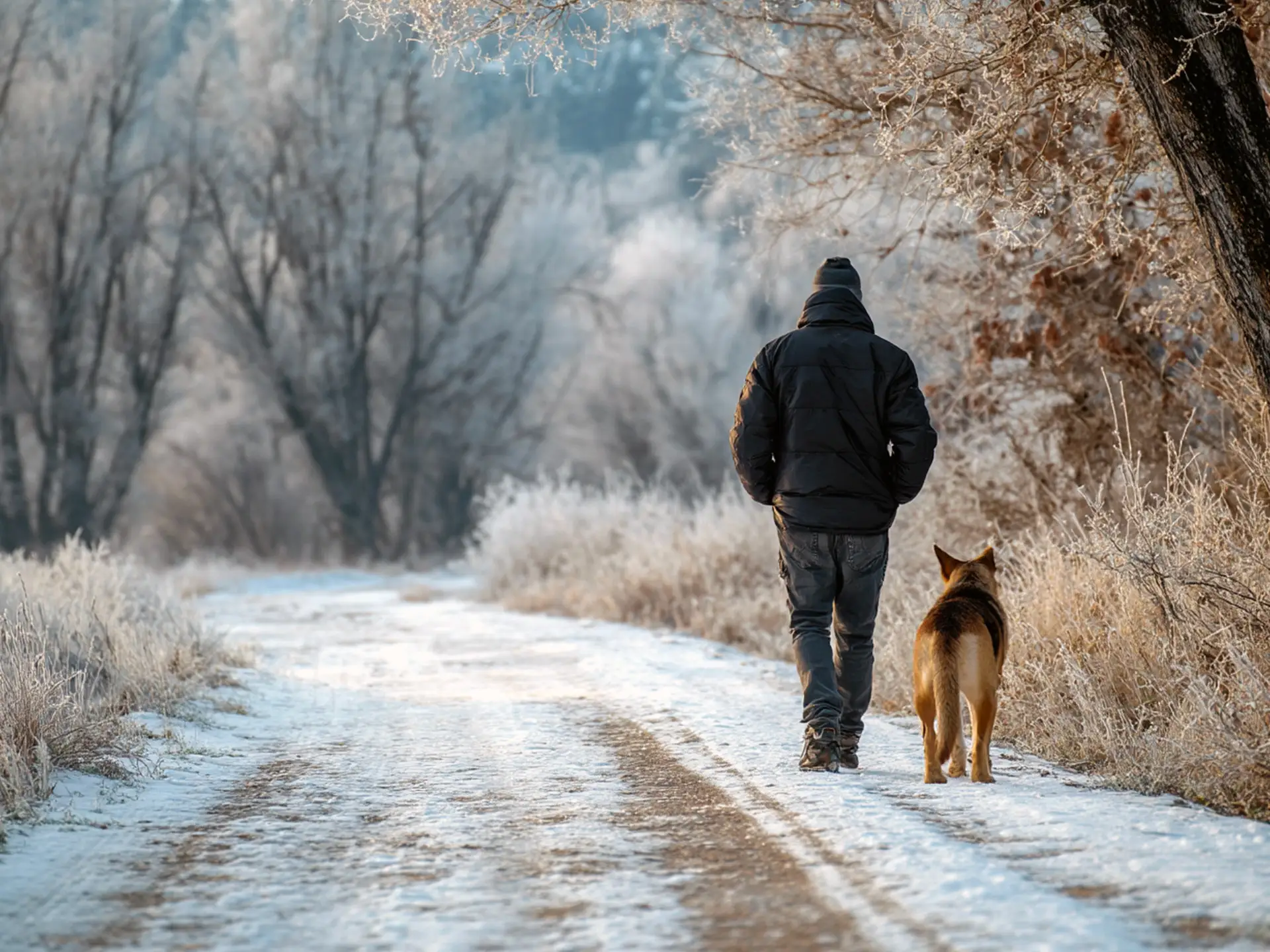
When winter sets in, walk length becomes one of the hardest things to judge. Too short, and your dog may not get enough stimulation or exercise. Too long, and you risk exposure to cold that can stress the body more than you realize. The right balance depends on temperature, wind, breed, and how conditioned your dog is for the season.
Understanding tolerance and timing
Healthy, medium or large breeds with thicker coats generally handle cold weather better. They can often walk comfortably for twenty to thirty minutes when the temperature stays above 32°F (0°C). Once the air dips closer to 20°F (minus 6°C), most dogs do better with shorter sessions of fifteen to twenty minutes. Below 10°F (minus 12°C), the goal shifts from exercise to quick relief walks — enough time for a bathroom break, not exploration.
Smaller breeds, senior dogs, and those with thin coats have much lower tolerance. For them, even 20°F can be challenging. Short, frequent outings work best, allowing them to warm up in between. Using boots and a coat can safely add a few extra minutes outdoors but only when the dog remains comfortable and active.
The role of wind and movement
Wind chill changes everything. Moving air strips warmth from the skin and can make a mild day feel dangerous. Choose routes with natural windbreaks such as buildings, fences, or tree lines. Keep your pace steady but relaxed. Continuous movement generates body heat, while frequent stops allow the cold to settle in faster.
A flexible guideline for safe walk times
| Air temperature | Recommended walk duration | Notes |
|---|---|---|
| Above 40°F (4°C and warmer) | 30–60 minutes | Normal walking conditions for most dogs. |
| 30–40°F (0–4°C) | 20–30 minutes | Watch for small or short-haired breeds showing discomfort. |
| 20–30°F (minus 6 to minus 1°C) | 10–20 minutes | Add boots or coat if your dog seems cold. |
| 10–20°F (minus 12 to minus 6°C) | 5–10 minutes | Keep to quick breaks or short strolls. |
| Below 10°F (minus 12°C) | Under 5 minutes | Only for essential potty breaks. |
These are general guidelines, not rules. The best measure is your dog’s behavior. If they seem bright, alert, and eager to continue, a few extra minutes are fine. If they slow down or hesitate, end the walk and warm up gradually indoors.
Expert insight
Conditioning can extend tolerance. Dogs that spend time outdoors daily in autumn naturally adjust to colder weather and may handle longer walks safely. Sudden exposure, however, is a shock to their system. If your dog spends most of the day inside, start with shorter winter walks and increase duration slowly to build comfort and stamina.
Key takeaway
The perfect winter walk is long enough to satisfy your dog’s energy but short enough to keep them safe. There’s no harm in breaking one big walk into two shorter ones if it means staying warm and happy. Let your dog’s body language, not the clock, tell you when it’s time to go home.
Winter Walking Schedule for Working Owners

Busy schedules don’t stop when the weather turns cold, and that’s often when dogs need routine the most. Short days and freezing mornings can make walks harder to fit in, but with a few changes, you can still give your dog the exercise and structure they need without losing warmth or time.
Morning walks before work
Cold mornings hit hardest, so keep this session short but purposeful. Focus on letting your dog relieve themselves, stretch, and sniff the air for a few minutes. A ten-minute brisk walk is usually enough to wake their body and mind. If it’s especially cold, start by playing indoors for a minute or two before heading outside. That little warm-up helps muscles adjust and prevents stiffness.
Midday break
If you can step out during lunch or hire a trusted dog walker, this is the best time for a longer walk. Midday offers the warmest temperatures and more light. Even fifteen to twenty minutes outdoors can prevent restlessness and reduce destructive behavior later. For apartment dogs, this is often the walk that keeps them happiest through winter.
Evening walks
After dark, focus on safety and stimulation rather than distance. Choose well-lit routes and reflective gear for visibility. Snow reflects car lights, which can disorient some dogs, so keep them close and use a secure harness. If it’s too cold for more than a few minutes outside, end the day with indoor enrichment — puzzle toys, obedience games, or scent work are perfect mental workouts.
Sample cold weather routine
| Time | Duration | Goal |
|---|---|---|
| 7:00 a.m. | 10 minutes | Potty break, light movement, quick sniff. |
| 12:30 p.m. | 20 minutes | Main exercise walk during daylight. |
| 6:30 p.m. | 10–15 minutes | Controlled evening outing, safety gear essential. |
| Before bed | 5 minutes | Quick relief walk, followed by towel dry and rest. |
Balancing activity and warmth
Consistency keeps dogs content in winter. Even when walks are short, keeping the same rhythm prevents anxiety and helps digestion. Dogs thrive on predictable patterns. Adjust only the length of walks based on temperature, not the schedule itself.
For high-energy breeds, pair shorter outdoor sessions with mental games indoors. Hide treats around the home, teach a new trick, or set up a quick scent trail. These simple activities make up for lost outdoor time and strengthen your bond during the colder months.
Key takeaway
Winter doesn’t have to disrupt your dog’s walking routine. A steady schedule with shorter, strategic outings gives them both comfort and stability. By working with the weather instead of against it, you can keep your dog healthy and content all season long.
Final Takeaway
Winter walks can look intimidating on the weather app, but for your dog, they are often moments of pure joy. The crisp air, the new scents carried on the wind, and the quiet world beneath a blanket of snow offer stimulation no indoor toy can match. The key is knowing when the cold becomes too much and how to adapt before it does.
Every dog has a different threshold. Some thrive in subzero mornings, while others prefer a quick outing and a warm blanket. What matters most is awareness. Check the temperature, read your dog’s signals, and prepare for each walk with the same care you’d take for a child in winter gear.
If you make cold weather safety a habit, your dog will start to associate winter with excitement, not discomfort. A good coat, clean paws, and shorter, well-timed walks are all it takes to keep them healthy through the season.
When the snow starts to fall, open the door with confidence. You know what your dog needs now, a walk that’s safe, enriching, and full of discovery. And if you’re looking for new routes to explore, DogPack’s interactive map can help you find dog-friendly trails and parks near you, even in the coldest months of the year.
Frequently Asked Questions
What temperature is too cold to walk a dog?
Most healthy adult dogs are comfortable until the air dips below 32°F (0°C). Once temperatures reach 20°F (minus 6°C) or lower, limit walks to short outings. Small, thin-coated, or senior dogs may need protection even sooner, especially in wind or wet snow.
How can I tell if my dog is too cold on a walk?
Watch for shivering, paw lifting, slowed movement, or tail tucking. These are early signs of discomfort. If your dog tries to turn back home, refuses to move, or looks tense, head inside immediately and warm them up gradually in a dry, draft-free room.
Can I walk my dog in the snow every day?
Yes, dogs can enjoy snow daily when the conditions are safe. Keep walks shorter, use paw protection, and avoid salted sidewalks. Always dry your dog thoroughly afterward and check their pads for redness or ice buildup before the next outing.
Do dogs need boots for cold weather?
Not always, but boots are essential on salted or icy surfaces. They prevent chemical burns, frostbite, and microcracks in the paw pads. For dogs that dislike boots, try paw wax as a lighter barrier. Introduce any gear gradually with treats and encouragement.
How long should a winter walk last?
For most dogs, 15 to 30 minutes is ideal in moderate cold. When temperatures drop near 20°F (minus 6°C) or lower, aim for 10 to 15 minutes at a steady pace. Below 10°F (minus 12°C), walks should be quick bathroom breaks only.
Can puppies go on walks in cold weather?
Puppies can walk in cold weather once fully vaccinated and properly bundled. Keep sessions very short and avoid deep snow. Young dogs lose body heat fast, so focus on positive experiences rather than distance. Gradual exposure helps them adapt safely to colder days.
Is salt on sidewalks harmful for dogs?
Yes. De-icing salt can irritate paws and cause chemical burns. If ingested, it may lead to stomach upset or poisoning. Rinse paws with warm water after every walk and dry thoroughly. Paw wax or boots provide excellent protection against salt exposure.
What should I do if my dog gets too cold outside?
Bring them indoors immediately and wrap them in a dry towel or blanket. Offer water, but avoid hot air or direct heat sources. If your dog remains lethargic, shivers uncontrollably, or seems disoriented, contact your veterinarian right away for further guidance.

